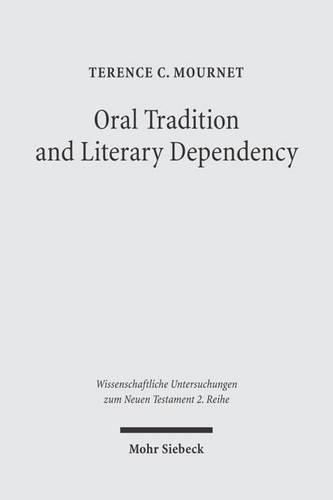Readings Newsletter
Become a Readings Member to make your shopping experience even easier.
Sign in or sign up for free!
You’re not far away from qualifying for FREE standard shipping within Australia
You’ve qualified for FREE standard shipping within Australia
The cart is loading…






With this work, Terence C. Mournet contributes to the ongoing discussion regarding oral tradition and the formation of the Synoptic Gospels. Synoptic studies have been marked by an excessive bias towards exclusively literary models of Synoptic interrelationships. Despite the widespread recognition that oral tradition played a significant role in the formation of the gospel tradition, the gospels are often examined as literary works apart from their relationship to oral performance. While not dismissing the use of written sources in the process of gospel composition, a study of the relationship in antiquity between oral communication and written texts leads us to re-examine any solution to the Synoptic Problem that does not take into adequate account the influence of oral tradition upon the development of the gospel tradition. Orality studies, and in particular folklore research, can help provide additional insight into the transmission of the early Jesus tradition and the formation of the Synoptic Gospels. The author examines various so-called ‘Q’ pericopes in light of the folkloristic characteristics of variability and stability, and he raises questions about how we envision the form and scope of a ‘Q’ text. While not discounting the assured results of literary methods of Gospel analysis, it is suggested that more serious attention be given to an oral performance model of early Christian tradition transmission.
$9.00 standard shipping within Australia
FREE standard shipping within Australia for orders over $100.00
Express & International shipping calculated at checkout
With this work, Terence C. Mournet contributes to the ongoing discussion regarding oral tradition and the formation of the Synoptic Gospels. Synoptic studies have been marked by an excessive bias towards exclusively literary models of Synoptic interrelationships. Despite the widespread recognition that oral tradition played a significant role in the formation of the gospel tradition, the gospels are often examined as literary works apart from their relationship to oral performance. While not dismissing the use of written sources in the process of gospel composition, a study of the relationship in antiquity between oral communication and written texts leads us to re-examine any solution to the Synoptic Problem that does not take into adequate account the influence of oral tradition upon the development of the gospel tradition. Orality studies, and in particular folklore research, can help provide additional insight into the transmission of the early Jesus tradition and the formation of the Synoptic Gospels. The author examines various so-called ‘Q’ pericopes in light of the folkloristic characteristics of variability and stability, and he raises questions about how we envision the form and scope of a ‘Q’ text. While not discounting the assured results of literary methods of Gospel analysis, it is suggested that more serious attention be given to an oral performance model of early Christian tradition transmission.